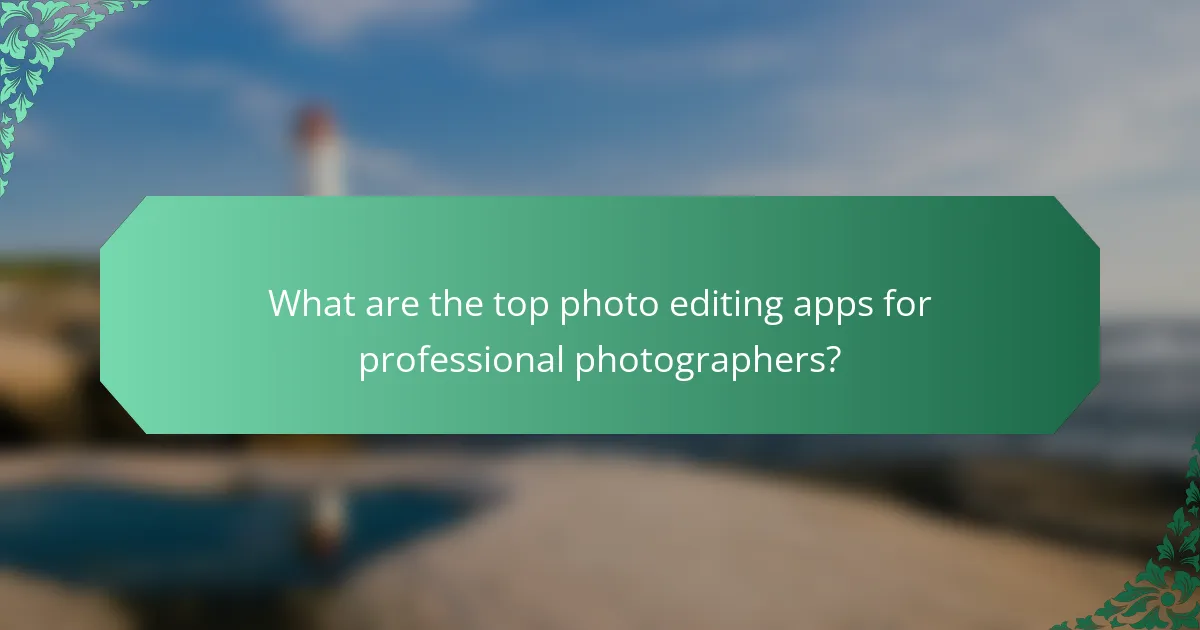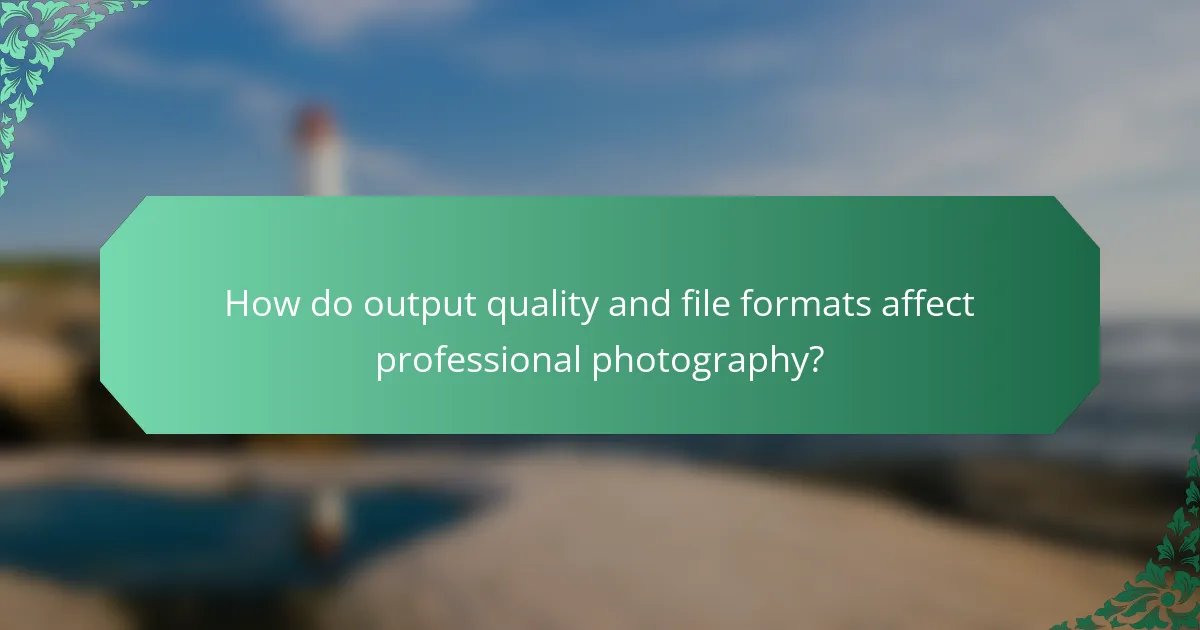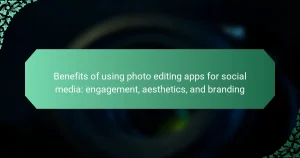Photo editing apps are essential tools for professional photographers, with Adobe Lightroom, Adobe Photoshop, Capture One, Affinity Photo, and ON1 Photo RAW being the leading options. These applications offer advanced features such as image manipulation, color grading, and customizable editing tools, catering to various professional needs. High output quality and the use of specific file formats like TIFF and RAW are crucial for preserving image detail and facilitating extensive editing. User experiences with these apps vary, highlighting both satisfaction with advanced functionalities and challenges related to learning curves and device performance. This article provides an overview of these top photo editing apps, focusing on their capabilities, output quality, and user feedback.

What are the top photo editing apps for professional photographers?
Adobe Lightroom, Adobe Photoshop, Capture One, Affinity Photo, and ON1 Photo RAW are the top photo editing apps for professional photographers. Adobe Lightroom offers advanced organization and editing tools. Adobe Photoshop is known for its extensive capabilities in image manipulation. Capture One provides powerful color grading and tethering options. Affinity Photo is a cost-effective alternative with robust features. ON1 Photo RAW combines editing and effects in a single workflow. These apps are widely recognized for their quality and versatility in professional photography.
How do these apps cater to the needs of professional photographers?
These apps cater to the needs of professional photographers by providing advanced editing tools and customization options. They offer features such as layer management, masking, and blending modes. Professional-grade filters and presets are available for quick adjustments. The apps support high-resolution image formats, ensuring quality output. They also provide batch processing capabilities for efficiency. Integration with cloud storage allows easy access to files. Collaboration features enable sharing and feedback from clients or teams. Tutorials and support resources help users maximize app functionality.
What features make these apps stand out in the market?
Top photo editing apps stand out due to advanced tools, customization options, and high output quality. These features enhance user experience and improve editing efficiency. Advanced tools include AI-driven enhancements, layer management, and professional-grade filters. Customization options allow users to create personalized workflows and presets. High output quality ensures images maintain resolution and color accuracy. Apps like Adobe Lightroom and Capture One exemplify these features, attracting professional photographers. Their unique capabilities set them apart in a competitive market.
How do user interfaces impact the usability of these apps?
User interfaces significantly impact the usability of photo editing apps. An intuitive user interface enhances user experience by making navigation straightforward. Clear icons and organized menus reduce the learning curve for new users. Consistent design elements improve familiarity and efficiency during photo editing tasks. A well-structured interface allows users to access advanced tools quickly, facilitating a smoother workflow. Research shows that usability testing correlates with increased user satisfaction, leading to higher retention rates. For example, a study by Nielsen Norman Group indicates that users prefer applications with clear visual hierarchies and responsive feedback. These factors collectively contribute to the overall effectiveness of photo editing apps for professional photographers.
What advanced tools do these apps offer?
Top photo editing apps for professional photographers offer advanced tools such as layer management, selective editing, and advanced color grading. Layer management allows users to work on different elements of an image independently. Selective editing enables adjustments to specific areas without affecting the entire photo. Advanced color grading tools provide precise control over hues, saturation, and luminance. Other features include noise reduction, lens correction, and perspective adjustments. These tools enhance image quality and provide creative flexibility. Many apps also support non-destructive editing, preserving original images while applying changes.
How do editing tools enhance photo quality?
Editing tools enhance photo quality by allowing adjustments to various image attributes. These tools can improve brightness, contrast, and saturation. They enable precise color correction to achieve accurate hues. Sharpness can be enhanced to make details stand out. Noise reduction features help eliminate unwanted graininess in images. Cropping tools allow for better composition and focus on the subject. Advanced filters can add artistic effects while maintaining clarity. Finally, saving options in high resolution ensures that the final output retains quality for printing or digital display.
What unique tools are available for specific photography styles?
Unique tools for specific photography styles include tilt-shift lenses for architectural photography. These lenses allow for perspective control, preventing distortion. Macro lenses are essential for close-up photography, capturing intricate details. For portrait photography, prime lenses with wide apertures create beautiful bokeh effects. Drone cameras are unique tools for aerial photography, providing stunning overhead shots. Underwater housings are necessary for underwater photography, protecting cameras from water damage. Finally, film cameras are distinctive tools for analog photography, offering a unique aesthetic. Each of these tools enhances the specific photography style by addressing its unique requirements.
Why is customization important in photo editing apps?
Customization is important in photo editing apps because it allows users to tailor their editing experience to individual preferences. This personalization enhances creativity by enabling unique artistic expressions. Users can adjust tools and features according to specific project needs. For example, advanced sliders for exposure or color balance can be fine-tuned to achieve desired effects. Customization also improves workflow efficiency. Users can save presets for frequently used adjustments, speeding up the editing process. According to a survey by Adobe, 70% of professional photographers prefer apps that offer extensive customization options. This preference highlights the necessity of flexibility in achieving high-quality results.
How can users personalize their editing experience?
Users can personalize their editing experience by adjusting interface settings and tool preferences. Most photo editing apps offer customizable workspaces. Users can rearrange panels and tools according to their workflow. They can also save different layouts for various projects. Furthermore, editing apps allow users to create and save presets for frequently used adjustments. This speeds up the editing process and ensures consistency. Some apps provide options to change keyboard shortcuts for efficiency. Additionally, users can select color themes that suit their visual preferences. These features enhance user comfort and productivity during editing tasks.
What are the benefits of customizable presets and filters?
Customizable presets and filters enhance efficiency and creativity in photo editing. They allow photographers to apply consistent styles across multiple images quickly. This saves time during the editing process, enabling faster workflow. Custom presets can be tailored to individual preferences, ensuring unique artistic expression. Additionally, they help maintain a cohesive look in a series of photos. Studies have shown that consistent editing styles can improve viewer engagement. Customizable options cater to various photography genres, from portraits to landscapes. Overall, these tools empower photographers to achieve professional results with ease.

How do output quality and file formats affect professional photography?
Output quality and file formats significantly impact professional photography. High output quality ensures images retain detail and clarity. Professional photographers often require images in formats like TIFF or RAW for maximum quality. These formats preserve more data than standard JPEGs. High-quality outputs are essential for large prints and detailed editing. They allow for better color grading and adjustments without loss of fidelity. Conversely, lower quality formats may result in pixelation or color distortion. Understanding file formats helps photographers choose the best option for their needs.
What file formats are supported by top photo editing apps?
Top photo editing apps support various file formats. Common formats include JPEG, PNG, TIFF, and RAW. JPEG is widely used for its balance of quality and file size. PNG supports transparency and is favored for web graphics. TIFF is preferred for high-quality images and professional printing. RAW formats, like CR2 and NEF, retain more image data for extensive editing. Many apps also support PSD, allowing compatibility with Adobe Photoshop files. These formats cater to diverse editing needs and output quality requirements.
How does file format choice impact image quality?
File format choice significantly impacts image quality. Different file formats use varying compression methods. Lossy formats like JPEG reduce file size but also degrade quality. Lossless formats like PNG maintain original quality but result in larger files. RAW formats capture the most detail and provide greater editing flexibility. For example, a JPEG image may lose fine details compared to a RAW file. Consequently, the choice of file format affects the clarity and detail of images.
What are the best practices for exporting images for different platforms?
Export images in the correct format for each platform. Use JPEG for web and social media due to its balance of quality and file size. PNG is ideal for images requiring transparency. For print, export in TIFF or high-resolution JPEG to maintain quality. Adjust the resolution based on the platform; 72 DPI is standard for web, while 300 DPI is necessary for print. Use sRGB color space for web images to ensure consistent color display. For social media, check platform-specific guidelines for optimal dimensions and aspect ratios. Optimize file sizes without compromising quality by using compression tools. These practices enhance image quality and ensure compatibility across platforms.
How do these apps ensure high output quality?
These apps ensure high output quality through advanced algorithms and precise editing tools. They utilize machine learning to enhance image resolution and detail. Many apps offer customizable settings for color correction and exposure adjustments. They also support high dynamic range (HDR) imaging, which captures more detail in highlights and shadows. Regular updates improve functionality and introduce new features. User feedback is often incorporated to refine performance. Compatibility with high-resolution formats ensures that output retains clarity. Finally, extensive testing and quality assurance processes validate the effectiveness of these features.
What algorithms or technologies are used for enhancing image quality?
Image quality enhancement utilizes algorithms and technologies like convolutional neural networks (CNNs), super-resolution, and image denoising techniques. CNNs are particularly effective in improving details and reducing noise. Super-resolution algorithms reconstruct high-resolution images from low-resolution inputs. Image denoising techniques remove unwanted noise while preserving essential details. Other methods include histogram equalization and sharpening filters, which enhance contrast and edge definition. These technologies are widely adopted in photo editing applications to provide professional-grade results.
How do resolution and color accuracy play a role in output quality?
Resolution and color accuracy are critical factors influencing output quality in photography. Higher resolution provides more detail and clarity in images. It allows for larger prints without losing sharpness. Color accuracy ensures that the colors in the final output match the original scene. This is essential for realistic representation and professional standards. Inaccurate colors can mislead viewers and diminish the overall impact of the image. Studies show that images with high resolution and accurate colors are perceived as more professional and engaging. Therefore, both attributes are vital for achieving high-quality photographic outputs.

What are the user experiences with these photo editing apps?
User experiences with photo editing apps vary widely. Many users report satisfaction with the advanced tools offered. They appreciate features like layers, masks, and customizable brushes. Users often highlight the intuitive interfaces that facilitate easy navigation. Some apps receive praise for their robust output quality. Users note that edited images retain high resolution and vibrancy. However, some users express frustration with learning curves in more complex apps. They mention that initial usage can be overwhelming. Additionally, users sometimes encounter performance issues on older devices. Overall, experiences can range from highly positive to challenging, depending on user familiarity and device capability.
What common challenges do photographers face when using these apps?
Photographers commonly face usability issues when using photo editing apps. These apps often have complex interfaces that can overwhelm users. Learning curves can be steep, requiring significant time to master advanced features. Additionally, performance issues may arise, such as slow processing speeds or crashes. Compatibility problems with different file formats can also hinder workflow. Limited customization options may restrict creative expression. Lastly, subscription costs can be a financial burden for some photographers. These challenges can impact the efficiency and effectiveness of their editing processes.
How can users troubleshoot common issues in photo editing apps?
Users can troubleshoot common issues in photo editing apps by following specific steps. First, they should ensure the app is updated to the latest version. Updates often fix bugs and improve performance. Next, users should check their device’s compatibility with the app. Some apps require specific operating systems or hardware specifications.
If the app crashes, users can try restarting the app or the device. This can resolve temporary glitches. Users should also clear the app’s cache if it allows that option. A full cache can slow down performance or cause crashes.
For issues with image quality, users should verify the resolution settings in the app. High-resolution images require more processing power. If tools are not functioning as expected, users can reset the app settings to default. This can resolve configuration issues.
Lastly, consulting the app’s support documentation or community forums can provide additional solutions. Many common issues have been documented with step-by-step fixes.
What tips can enhance the workflow for professional photographers?
To enhance the workflow for professional photographers, adopting efficient organization and editing strategies is crucial. Implementing a solid file management system can streamline access to images. Utilizing software with batch processing capabilities saves time in editing multiple photos. Setting up customized presets for common adjustments can speed up the editing process. Regularly backing up files ensures data security and prevents loss. Additionally, using tethering during shoots allows for immediate review of images. Investing in high-quality equipment can reduce technical issues and improve output quality. Lastly, maintaining a consistent workflow helps in managing time effectively. These practices collectively contribute to a more efficient photography workflow.
What are the best practices for choosing a photo editing app?
Identify your specific editing needs. Consider whether you require basic adjustments or advanced features. Research app compatibility with your device. Check if the app supports your operating system. Evaluate user interface and ease of use. A user-friendly design enhances productivity. Look for customization options. Advanced tools allow tailored editing experiences. Read user reviews and ratings. Feedback provides insights into app performance. Test free trials when available. This helps assess functionality before purchase. Check for regular updates and support. Ongoing development indicates a reliable app.
How can photographers assess their editing needs before selecting an app?
Photographers can assess their editing needs by evaluating their specific workflow requirements. They should identify the types of edits they frequently perform, such as color correction, retouching, or compositing. Understanding the complexity of their projects helps in determining the necessary features. For instance, some may need advanced tools like layers and masks, while others may require basic adjustments.
Photographers should also consider their preferred file formats and output quality. The app must support formats like RAW or TIFF if high-quality output is essential. Additionally, they should assess their device compatibility. Some apps may perform better on certain operating systems or hardware configurations.
Finally, reading reviews and user feedback can provide insights into how well an app meets specific editing needs. This approach ensures photographers select an app that aligns with their unique editing style and project demands.
What factors should influence the decision when selecting a photo editing app?
Key factors influencing the selection of a photo editing app include features, usability, compatibility, and cost. Features such as advanced editing tools, filters, and presets are essential for professional results. Usability impacts the learning curve and efficiency of the editing process. Compatibility with various file formats and operating systems ensures seamless integration into existing workflows. Cost should align with the budget and value provided by the app. According to a survey by Digital Photography School, 70% of photographers prioritize features over cost when selecting editing software.
The main entity of the article is top photo editing apps for professional photographers. The article provides an overview of leading applications such as Adobe Lightroom, Adobe Photoshop, Capture One, Affinity Photo, and ON1 Photo RAW, highlighting their advanced tools, customization options, and output quality. It discusses how these apps cater to photographers’ needs through features like layer management, selective editing, and high-resolution support. Additionally, it addresses user interface impact, the importance of customization, and best practices for selecting and using photo editing software effectively.


